Enhancement of Hosting Capacity with Soft Open Points and Distribution System Reconfiguration: Multi-Objective Bilevel Stochastic Optimization
Abstract
1. Introduction
- (1)
- A multi-objective bilevel optimization problem is formulated to minimize the total active losses by introducing DSR to a lower level problem and then to maximize the HC and minimize the annual total cost for two real distribution systems.
- (2)
- A probabilistic HC maximization approach is proposed to illustrate the expected impact of load uncertainties on HC.
- (3)
- The proposed optimization approach ensures radiality among the studied distribution networks while reconfiguring the non-SOP tie-lines in a short time.
- (4)
- A combination of DSR and SOPs is successfully used to support the penetration of DGs in distribution systems while guaranteeing an economic planning framework.
2. Materials and Methods
2.1. Power Flow Equations
2.2. Distribution System Reconfiguration
2.3. DG Modeling
2.4. SOP Modeling
2.4.1. Deterministic Case
2.4.2. Probabilistic Case
2.5. Scenario Reduction
3. Problem Formulation
3.1. Deterministic HC
3.1.1. Upper Level
3.1.2. Lower Level
3.2. Probabilistic HC
3.2.1. Upper Level
3.2.2. Lower Level
- (a)
- Apply the sth loading level to the connected loads.
- (b)
- Set DGs locations according to .
- (c)
- If (1)–(3), (6), (10),(11), (15)–(17), and (36)–(38) violated, then return , and equal to infinity, and zero, respectively. Then, the optimization process continues by setting new parameters’ values at Step 2.
- (d)
- Set the DGs, and SOPs injected powers.
- (e)
- Run the power flow.
- (f)
- The lower level optimization procedure takes place at this sub-step by reconfiguring the non-SOP tie-lines.
- (g)
- Repeat Step 4 till finishing all the scenarios.
4. Results and Discussion
4.1. Deterministic Case Study
4.1.1. Real 59-Node Distribution System in Cairo
4.1.2. Real 83-Node Distribution System in Taiwan
4.2. Probabilistic Case Study
4.2.1. Real 59-Node Distribution System in Cairo
4.2.2. 83-Node Distribution System
5. Conclusions
Author Contributions
Funding
Conflicts of Interest
Nomenclature
| Input Data | |
| Loss coefficient of each VSC | |
| Set of nodes | |
| Electricity price | |
| SOP capital cost per unit capacity | |
| Maximum line current of the bth line | |
| Total number of lines | |
| Total number of nodes | |
| Total number of tie-lines | |
| Total number of scenarios | |
| Number of the installed SOPs | |
| Demanded active power at node | |
| Probability of the sth scenario | |
| Number of years | |
| Set of all scenarios | |
| Maximum size of the installed DGs | |
| Maximum SOP size | |
| Set of tie-lines | |
| Lower voltage limit | |
| Upper voltage limit | |
| Set of lines | |
| Impedance of the bth line | |
| SOP annual operation cost coefficient | |
| Decision Variables of the DSR, the SOP size and location | |
| A binary vector indicates the best open/close status of the distribution system tie-lines | |
| A temporary binary vector indicates open/close status of the system tie-lines | |
| Binary variable allows SOP allocation instead of the yth tie-line | |
| , | VSC size at the Ith, and Jth feeders |
| Decision Variables of the Deterministic Case Study | |
| Binary variable allows DG allocation at the uth node when its value equals to one. | |
| Injected active power by the uth DG | |
| SOP active power injected at the Ith feeder | |
| SOP reactive power injected at the Ith and the Jth feeders | |
| Decision Variables of the Probabilistic Case Study | |
| Binary variable indicates DG allocation | |
| Injected active power by the uth DG | |
| SOP active power injected to the Ith feeder | |
| SOP reactive power injected to the Ith feeder | |
| SOP reactive power injected at the Jth feeder | |
References
- Shukla, A.K.; Ahmad, Z.; Sharma, M.; Dwivedi, G.; Verma, T.N.; Jain, S.; Verma, P.; Zare, A. Advances of Carbon Capture and Storage in Coal-Based Power Generating Units in an Indian Context. Energies 2020, 13, 4124. [Google Scholar] [CrossRef]
- Zsiborács, H.; Baranyai, N.H.; Vincze, A.; Zentkó, L.; Birkner, Z.; Máté, K.; Pintér, G. Intermittent Renewable Energy Sources: The Role of Energy Storage in the European Power System of 2040. Electronics 2019, 8, 729. [Google Scholar] [CrossRef]
- Zappa, W.; Junginger, M.; Broek, M.V.D. Is a 100% renewable European power system feasible by 2050? Appl. Energy 2019, 233–234, 1027–1050. [Google Scholar] [CrossRef]
- Aleem, S.A.; Hussain, S.S.; Ustun, T.S. A Review of Strategies to Increase PV Penetration Level in Smart Grids. Energies 2020, 13, 636. [Google Scholar] [CrossRef]
- Ismael, S.M.; Aleem, S.H.A.; Abdelaziz, A.Y.; Zobaa, A.F. State-of-the-art of hosting capacity in modern power systems with distributed generation. Renew. Energy 2019, 130, 1002–1020. [Google Scholar] [CrossRef]
- Fatima, S.; Püvi, V.; Lehtonen, M. Review on the PV Hosting Capacity in Distribution Networks. Energies 2020, 13, 4756. [Google Scholar] [CrossRef]
- Mulenga, E.; Bollen, M.H.J.; Etherden, N. A review of hosting capacity quantification methods for photovoltaics in low-voltage distribution grids. Int. J. Electr. Power Energy Syst. 2020, 115, 105445. [Google Scholar] [CrossRef]
- Abideen, M.Z.U.; Ellabban, O.; Al-Fagih, L. A Review of the Tools and Methods for Distribution Networks’ Hosting Capacity Calculation. Energies 2020, 13, 2758. [Google Scholar] [CrossRef]
- Pandi, V.R.; Zeineldin, H.H.; Xiao, W.; Zobaa, A.F. Optimal penetration levels for inverter-based distributed generation considering harmonic limits. Electr. Power Syst. Res. 2013, 97, 68–75. [Google Scholar] [CrossRef]
- Ismael, S.M.; Aleem, S.H.E.A.; Abdelaziz, A.Y.; Zobaa, A.F. Probabilistic Hosting Capacity Enhancement in Non-Sinusoidal Power Distribution Systems Using a Hybrid PSOGSA Optimization Algorithm. Energies 2019, 12, 1018. [Google Scholar] [CrossRef]
- Ismael, S.M.; Aleem, S.H.E.A.; Abdelaziz, A.Y.; Zobaa, A.F. Practical Considerations for Optimal Conductor Reinforcement and Hosting Capacity Enhancement in Radial Distribution Systems. IEEE Access 2018, 6, 27268–27277. [Google Scholar] [CrossRef]
- Alalamat, F. Increasing the Hosting Capacity of Radial Distribution Grids in Jordan. Bachelor’s Thesis, Uppsala University, Uppsala, Sweden, 2015. Available online: http://www.diva-portal.org/smash/record.jsf?pid=diva2%3A833570&dswid=5802 (accessed on 5 October 2020).
- Alturki, M.; Khodaei, A. Increasing Distribution Grid Hosting Capacity through Optimal Network Reconfiguration. In Proceedings of the 2018 North American Power Symposium (NAPS), Fargo, ND, USA, 9–11 September 2018; pp. 1–6. [Google Scholar]
- Falabretti, D.; Merlo, M.; Delfanti, M. Network reconfiguration and storage systems for the hosting capacity improvement. In Proceedings of the 22nd International Conference on Electricity Distribution, Stockholm, Sweden, 10–13 June 2013; pp. 10–13. [Google Scholar]
- Fu, Y.Y.; Chiang, H.D. Toward optimal multi-period network reconfiguration for increasing the hosting capacity of distribution networks. In Proceedings of the IEEE Power Energy Society General Meeting 2018, Portland, OR, USA, 5–9 August 2018; pp. 1–5. [Google Scholar]
- Fu, Y.-Y.; Chiang, H.-D. Toward Optimal Multiperiod Network Reconfiguration for Increasing the Hosting Capacity of Distribution Networks. IEEE Trans. Power Deliv. 2018, 33, 2294–2304. [Google Scholar] [CrossRef]
- Capitanescu, F.; Ochoa, L.F.; Margossian, H.; Hatziargyriou, N.D. Assessing the Potential of Network Reconfiguration to Improve Distributed Generation Hosting Capacity in Active Distribution Systems. IEEE Trans. Power Syst. 2015, 30, 346–356. [Google Scholar] [CrossRef]
- Takenobu, Y.; Yasuda, N.; Minato, S.; Hayashi, Y. Scalable enumeration approach for maximizing hosting capacity of distributed generation. Int. J. Electr. Power Energy Syst. 2019, 105, 867–876. [Google Scholar] [CrossRef]
- Xu, X.; Li, J.; Xu, Z.; Zhao, J.; Lai, C.S. Enhancing photovoltaic hosting capacity—A stochastic approach to optimal planning of static var compensator devices in distribution networks. Appl. Energy 2019, 238, 952–962. [Google Scholar] [CrossRef]
- Divshali, P.H.; Soder, L. Improving Hosting Capacity of Rooftop PVs by Quadratic Control of an LV-Central BSS. IEEE Trans. Smart Grid 2017, 10, 919–927. [Google Scholar] [CrossRef]
- Alturki, M.; Khodaei, A.; Paaso, A.; Bahramirad, S. Optimization-based distribution grid hosting capacity calculations. Appl. Energy 2018, 219, 350–360. [Google Scholar] [CrossRef]
- Al-Saadi, H.; Zivanovic, R.; Al-Sarawi, S.F. Probabilistic Hosting Capacity for Active Distribution Networks. IEEE Trans. Ind. Inform. 2017, 13, 2519–2532. [Google Scholar] [CrossRef]
- Ji, H.; Li, P.; Wang, C.; Song, G.; Zhao, J.; Su, H.; Wu, J. A Strengthened SOCP-based Approach for Evaluating the Distributed Generation Hosting Capacity with Soft Open Points. Energy Procedia 2017, 142, 1947–1952. [Google Scholar] [CrossRef]
- Thomas, L.J.; Burchill, A.; Rogers, D.J.; Guest, M.; Jenkins, N. Assessing distribution network hosting capacity with the addition of soft open points. In Proceedings of the IET Conference Publications; IEEE: Piscataway, NJ, USA, 2016. [Google Scholar]
- Ji, H.; Wang, C.; Li, P.; Zhao, J.; Song, G.; Wu, J. Quantified flexibility evaluation of soft open points to improve distributed generator penetration in active distribution networks based on difference-of-convex programming. Appl. Energy 2018, 218, 338–348. [Google Scholar] [CrossRef]
- Mohamed Diaaeldin, I.; Abdel Aleem, S.H.E.; El-Rafei, A.; Abdelaziz, A.Y.; Zobaa, A.F. A Novel Graphically-Based Network Reconfiguration for Power Loss Minimization in Large Distribution Systems. Mathematics 2019, 7, 1182. [Google Scholar] [CrossRef]
- Bloemink, J.M.; Green, T.C. Increasing photovoltaic penetration with local energy storage and soft normally-open points. In Proceedings of the 2011 IEEE Power and Energy Society General Meeting, Detroit, MI, USA, 24–28 July 2011; pp. 1–8. [Google Scholar]
- Bloemink, J.M.; Green, T.C. Benefits of Distribution-Level Power Electronics for Supporting Distributed Generation Growth. IEEE Trans. Power Deliv. 2013, 28, 911–919. [Google Scholar] [CrossRef]
- Diaaeldin, I.M.; Aleem, S.H.E.A.; El-Rafei, A.; Abdelaziz, A.Y.; Zobaa, A.F. Optimal Network Reconfiguration in Active Distribution Networks with Soft Open Points and Distributed Generation. Energies 2019, 12, 4172. [Google Scholar] [CrossRef]
- Wang, C.; Song, G.; Li, P.; Ji, H.; Zhao, J.; Wu, J. Optimal siting and sizing of soft open points in active electrical distribution networks. Appl. Energy 2017, 189, 301–309. [Google Scholar] [CrossRef]
- Growe-Kuska, N.; Heitsch, H.; Romisch, W. Scenario reduction and scenario tree construction for power management problems. In Proceedings of the 2003 IEEE Bologna Power Tech Conference Proceedings, Bologna, Italy, 23–26 June 2003; Volume 3, pp. 152–158. [Google Scholar]
- Hwang, C.-L.; Lai, Y.-J.; Liu, T.-Y. A new approach for multiple objective decision making. Comput. Oper. Res. 1993, 20, 889–899. [Google Scholar] [CrossRef]
- Saleh, O.A.; Elshahed, M.; Elsayed, M. Enhancement of radial distribution network with distributed generation and system reconfiguration. J. Electr. Syst. 2018, 14, 36–50. [Google Scholar]
- Brownlee, A.E.I.; Wright, J.A. Constrained, mixed-integer and multi-objective optimisation of building designs by NSGA-II with fitness approximation. Appl. Soft Comput. 2015, 33, 114–126. [Google Scholar] [CrossRef]
- Zhao, X.; Jin, Y.; Ji, H.; Geng, J.; Liang, X.; Jin, R. An improved mixed-integer multi-objective particle swarm optimization and its application in antenna array design. In Proceedings of the 2013 5th IEEE International Symposium on Microwave, Antenna, Propagation and EMC Technologies for Wireless Communications, Chengdu, China, 29–31 October 2013; pp. 412–415. [Google Scholar]
- Mirjalili, S.; Jangir, P.; Mirjalili, S.Z.; Saremi, S.; Trivedi, I.N. Optimization of problems with multiple objectives using the multi-verse optimization algorithm. Knowl. Based Syst. 2017, 134, 50–71. [Google Scholar] [CrossRef]
- PCS 6000 for Large Wind Turbines: Medium Voltage, Full Power Converters Up to 9 MVA. ABB, Brochure 3BHS351272 E01 Rev. A. Available online: http://new.abb.com/docs/default-source/ewea-doc/pcs6000wind.pdf (accessed on 10 October 2020).
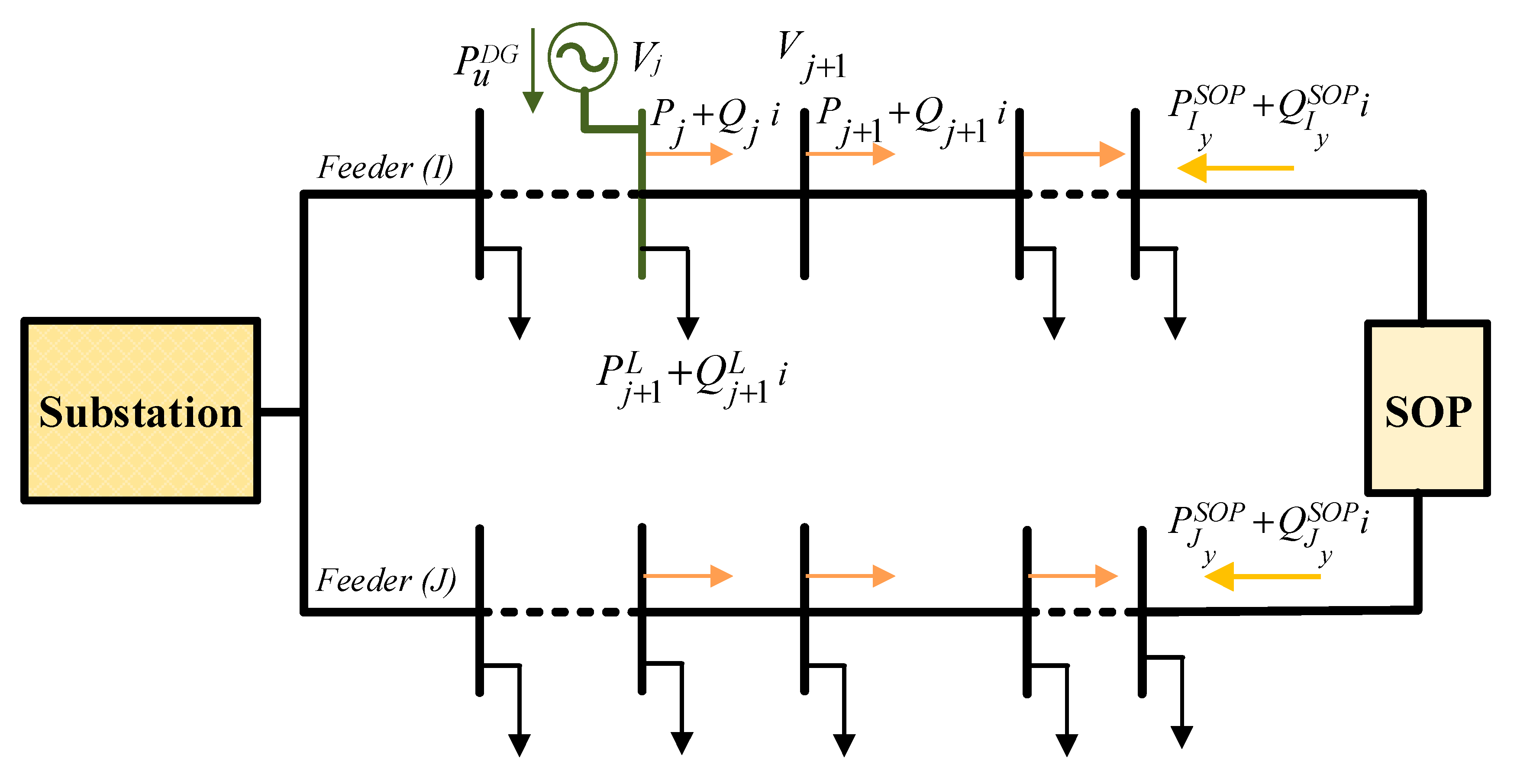

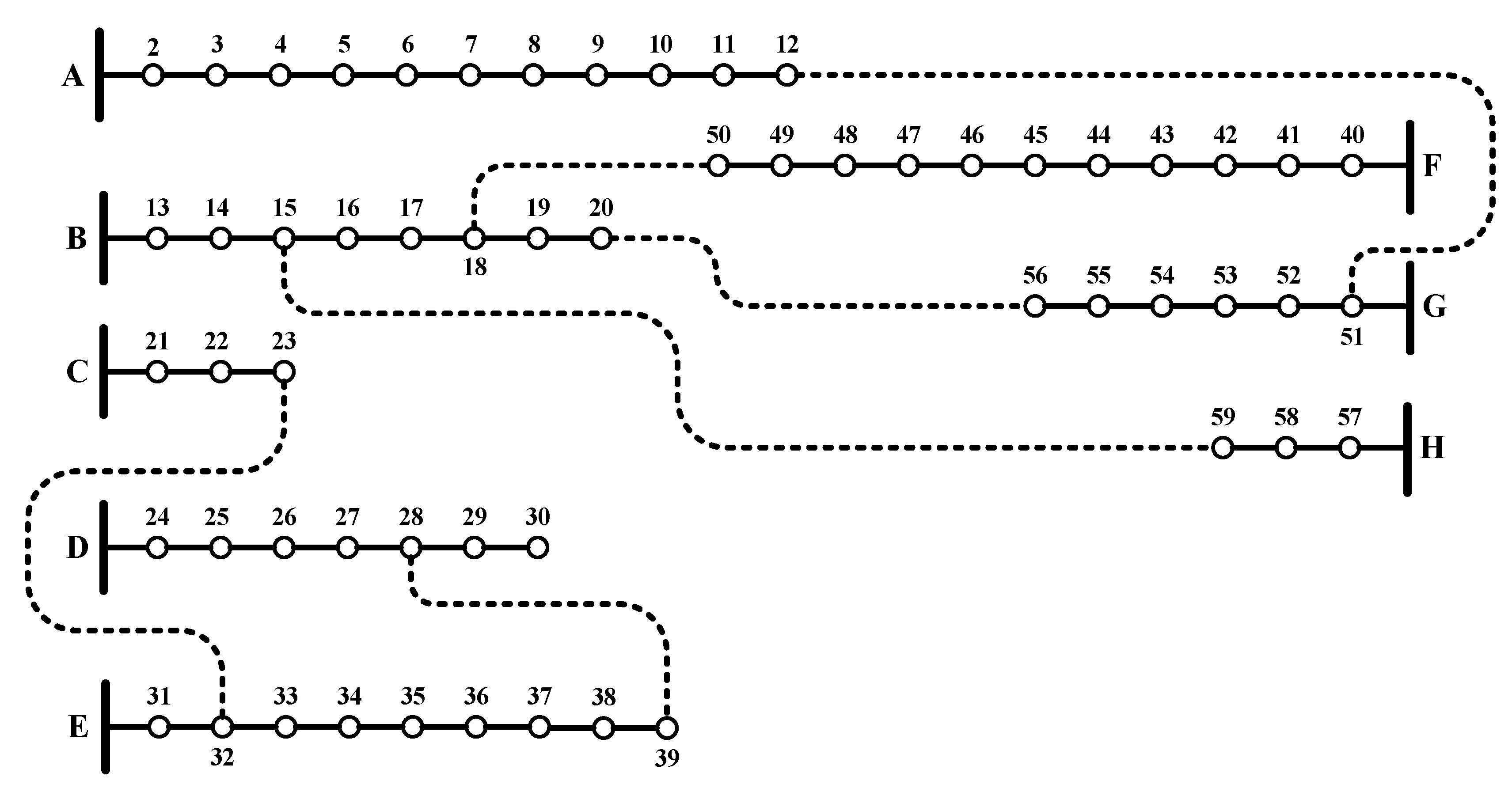
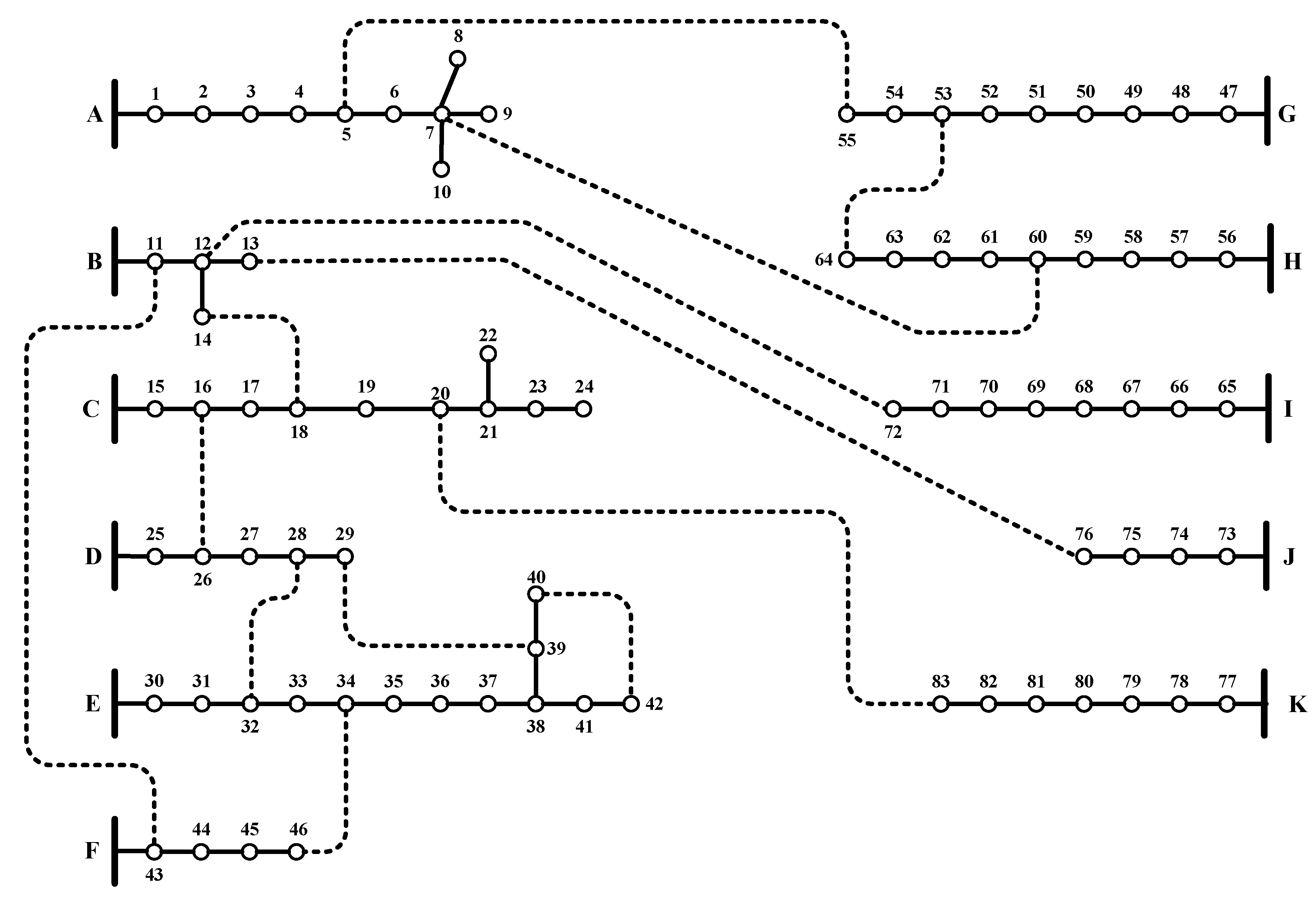


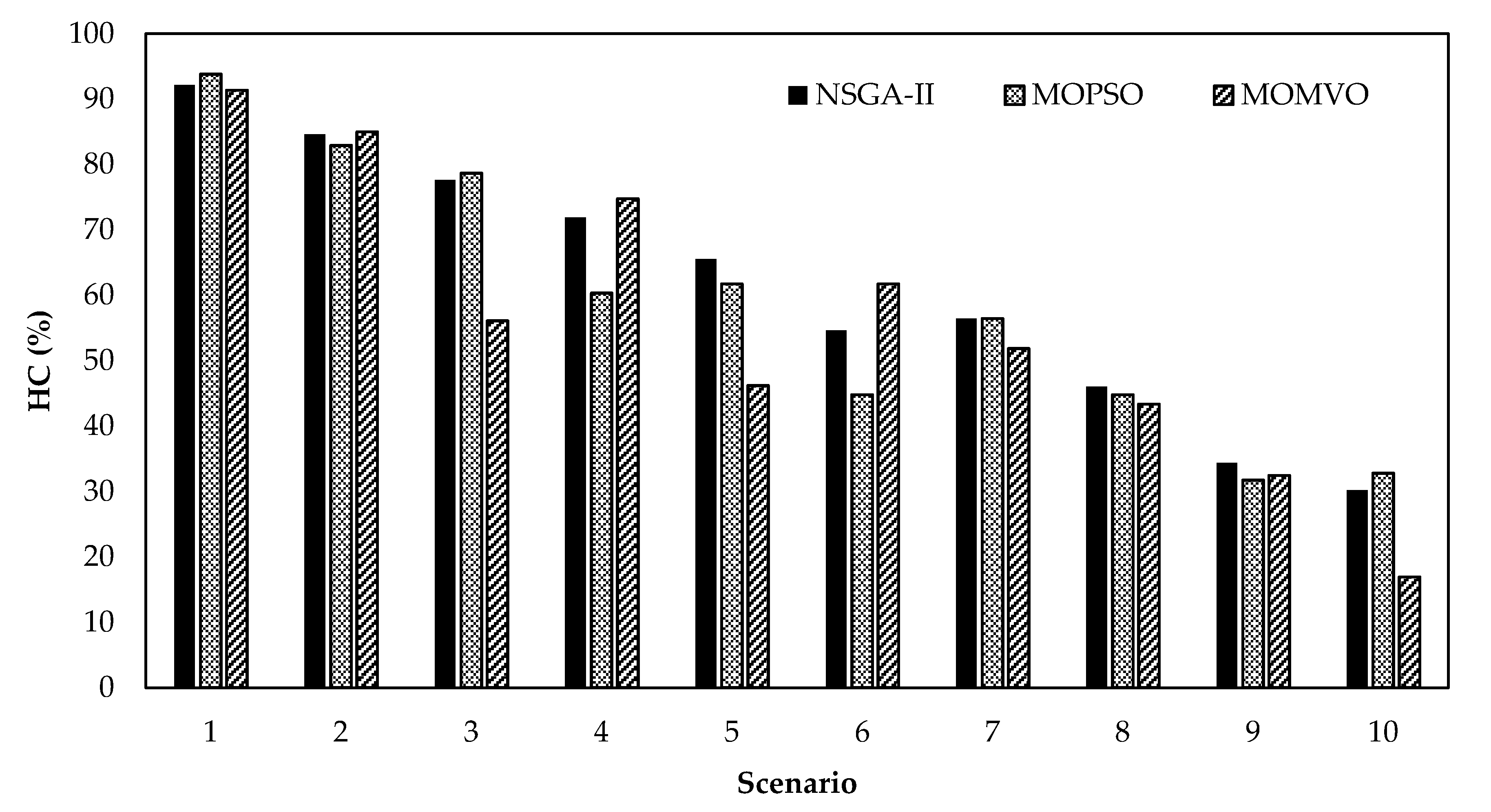
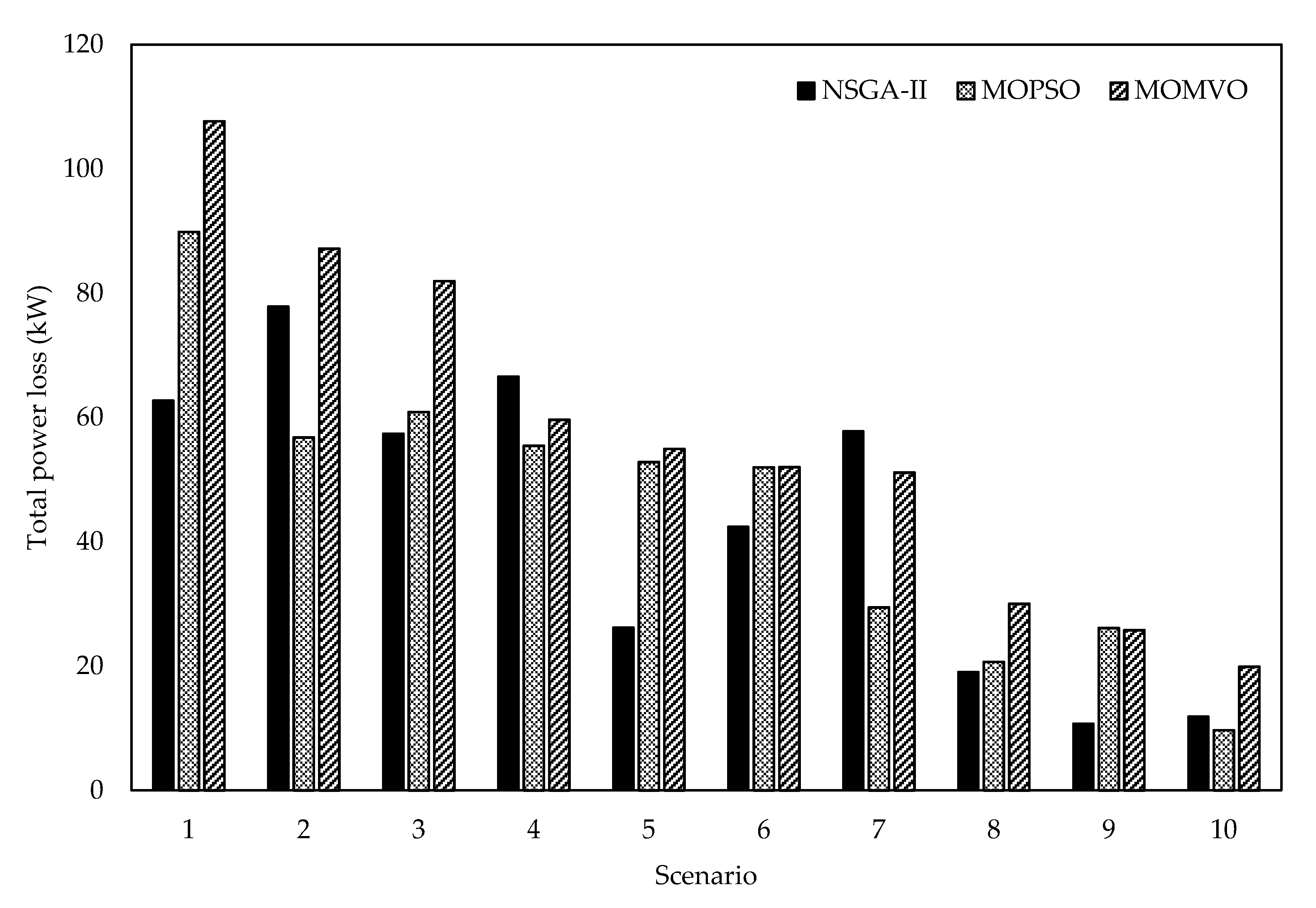



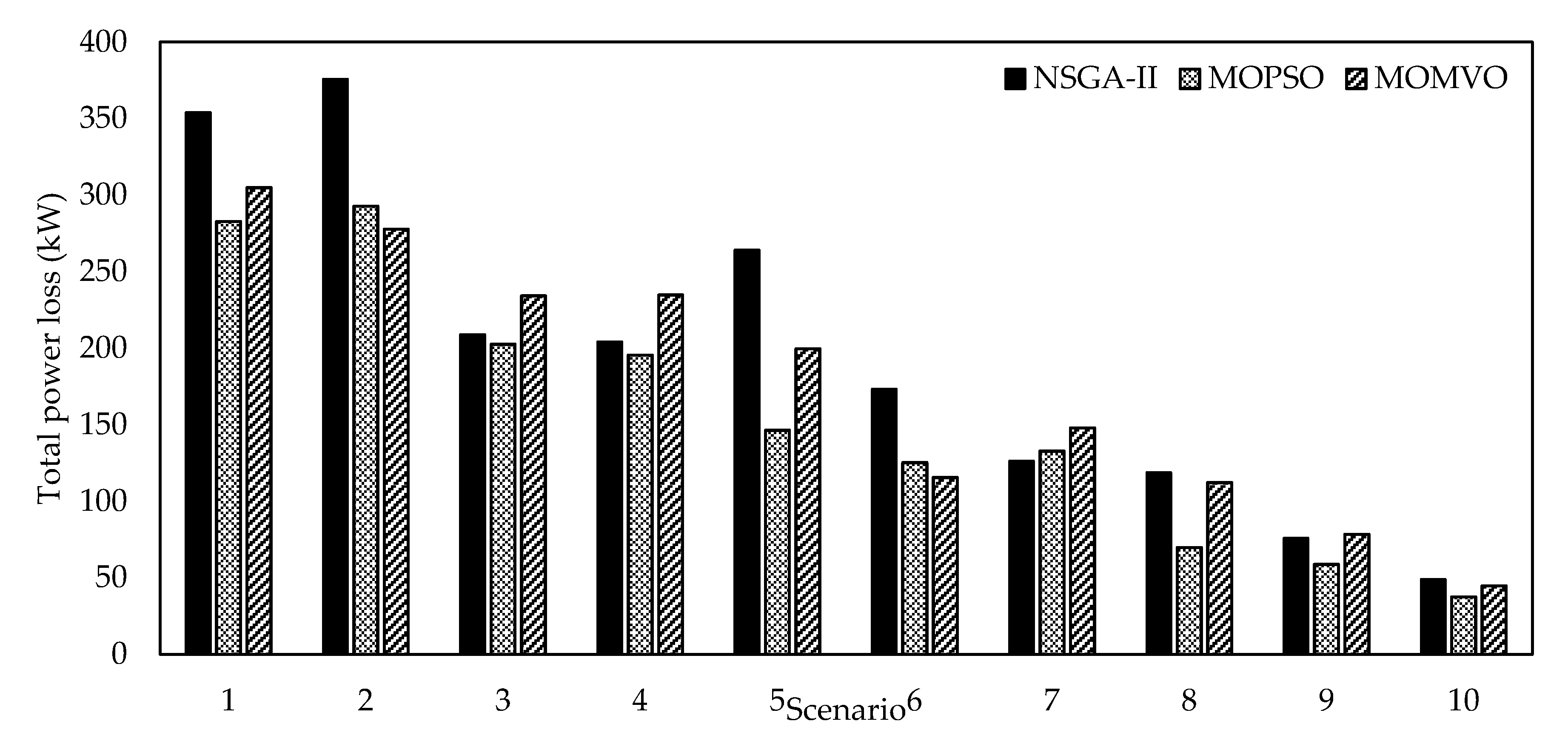
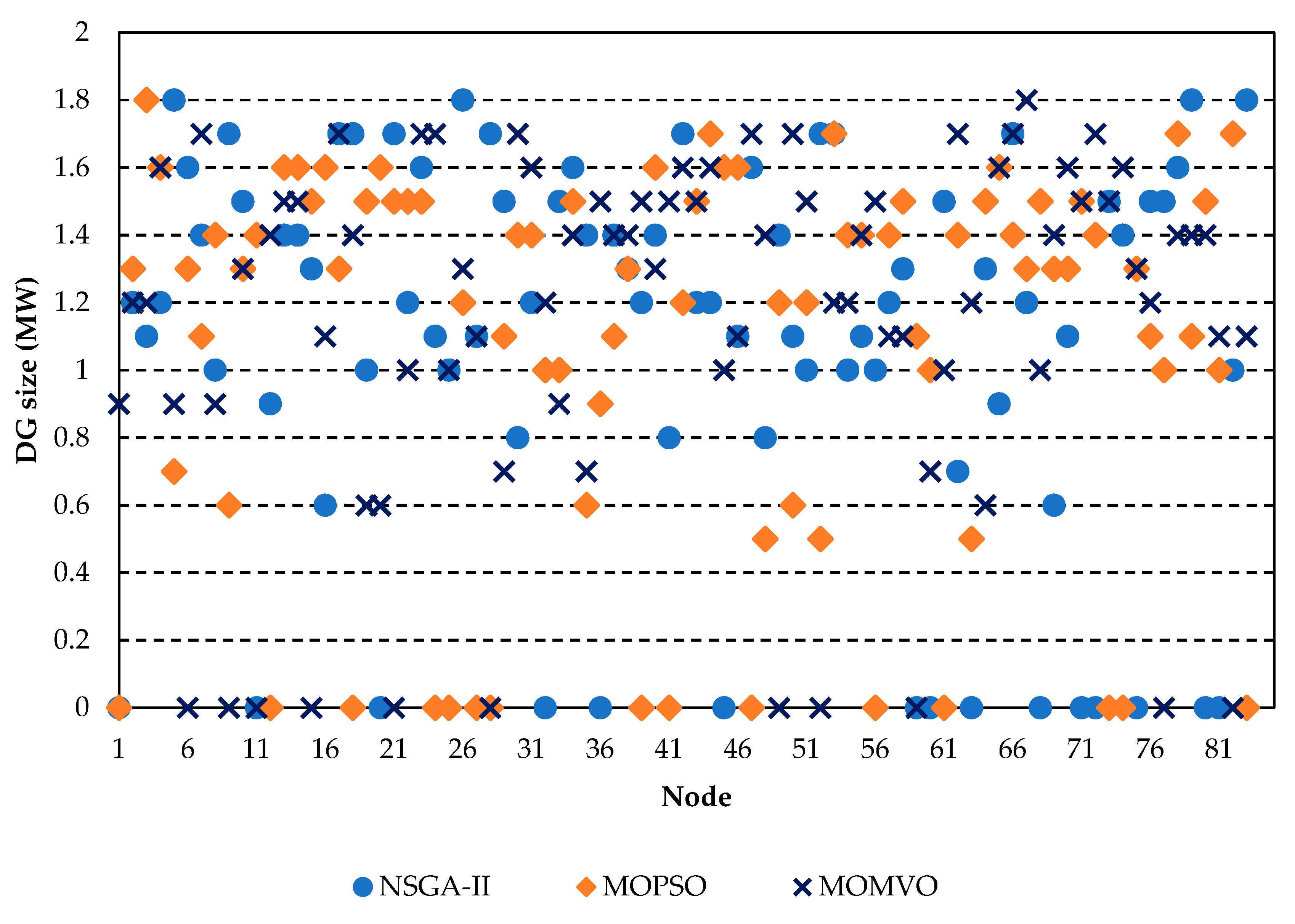
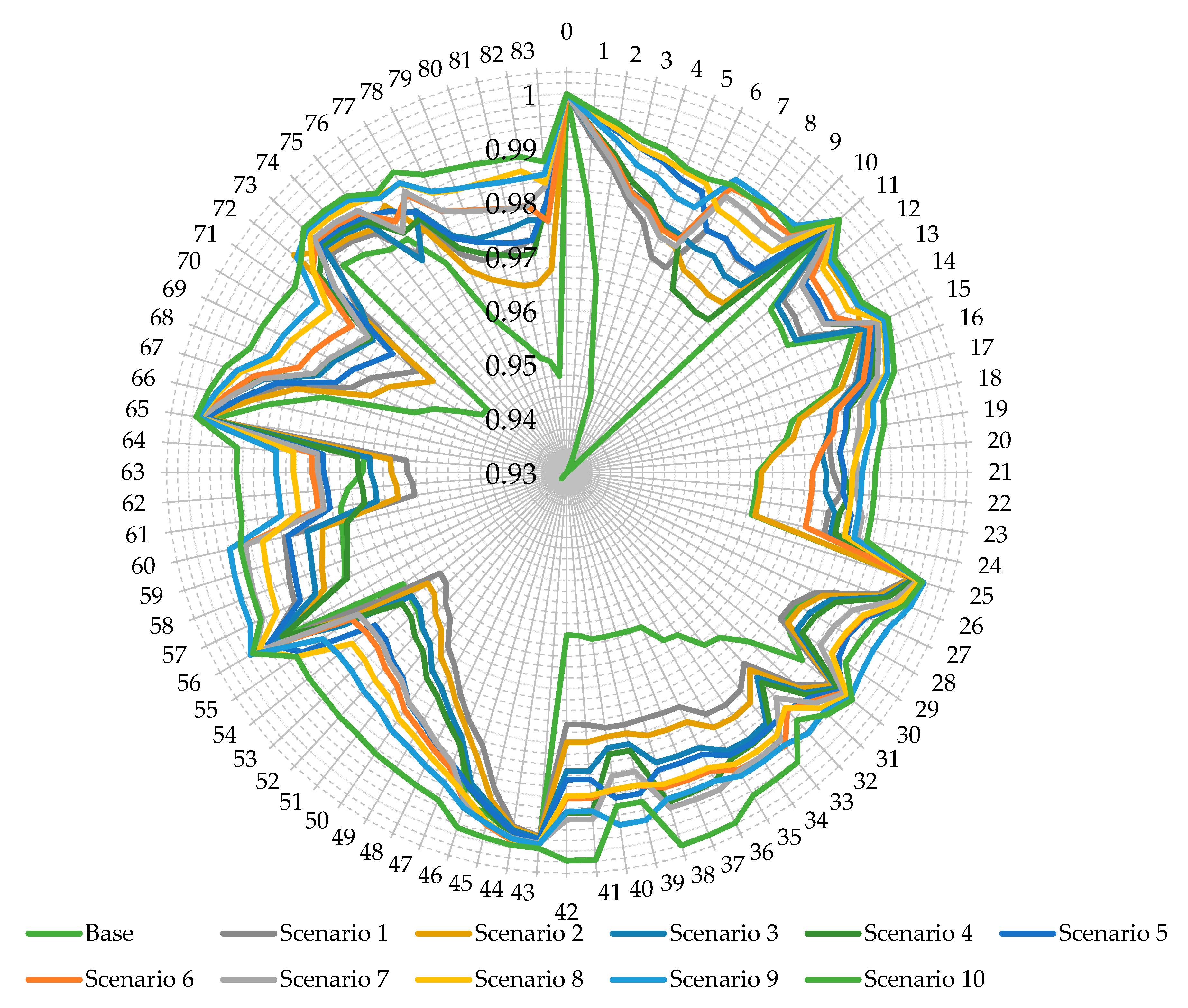
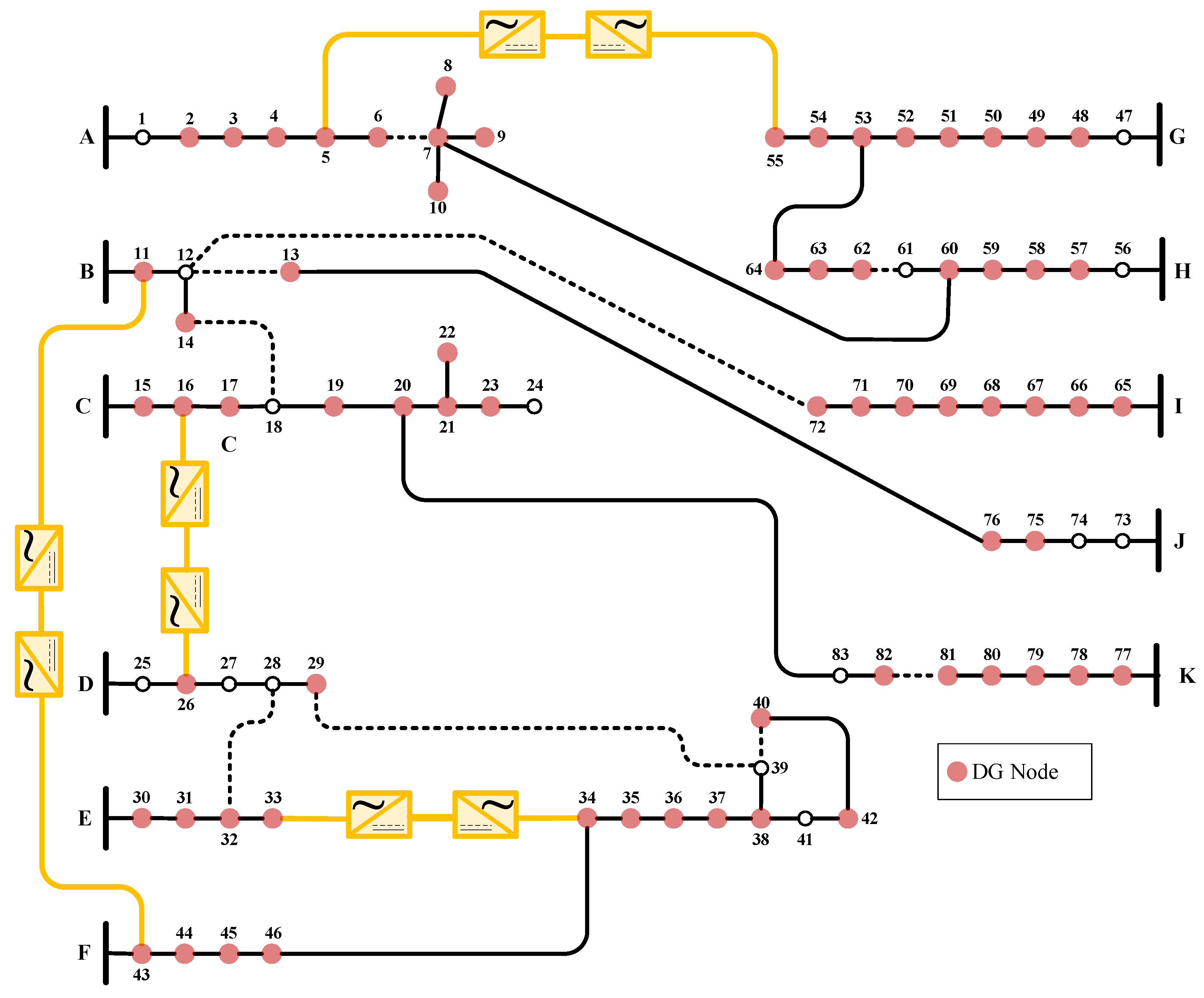
| Parameter | Value | Parameter | Value | Parameter | Value |
|---|---|---|---|---|---|
| 0.08 | 0.01 | [30,37] | 0.02 | ||
| ($/kWh) | 0.06 | (MVA) | [0,30] | (A) | 300 |
| ($/kVA) [30] | 308.8 | (MVA) | [0,5] | (p.u.) | 0.95 |
| (years) | 20 | (p.u.) | 1.05 |
| Oimizer | ||||
|---|---|---|---|---|
| Initial | - | 115,056.665 | 115,056.665 | - |
| NSGA-II | 98.72 | 23,362.679 | 19,908.683 | 3145.196 |
| MOPSO | 98.72 | 23,471.887 | 20,017.891 | |
| MOMVO | 98.92 | 30,382.875 | 26,928.879 |
| Optimizer | Tie-Lines | SOP-Lines | SOP-Size (kVA) |
|---|---|---|---|
| NSGA-II | 7–8, 18–19, 28–39, 46–47, and 23–32 | 15–59 | 100 |
| MOPSO | 18–19, 46–47, 15–59, 23–32, and 28–39 | 7–8 | 100 |
| MOMVO | 100 |
| Node | Size (MVA) | Node | Size (MVA) | Node | Size (MVA) |
|---|---|---|---|---|---|
| 2 | 2.0 | 16 | 2.0 | 41 | 2.4 |
| 6 | 2.1 | 18 | 2.1 | 43 | 2.2 |
| 9 | 2.3 | 22 | 2.4 | 45 | 2.5 |
| 12 | 2.7 | 26 | 2.7 | 49 | 2.8 |
| 13 | 2.7 | 27 | 2.1 | 50 | 2.9 |
| 14 | 2.2 | 35 | 2.5 | 53 | 2.1 |
| 15 | 2.5 | 37 | 2.4 | 57 | 2.2 |
| Optimizer | ||||
|---|---|---|---|---|
| Initial | - | 279,692.043 | 279,692.043 | - |
| NSGA-II | 99.118 | 169,294.656 | 152,024.675 | 15,725.981 |
| MOPSO | 99.118 | 154,374.821 | 144,012.833 | 9435.5886 |
| MOMVO | 98.765 | 171,268.356 | 15,0544.379 | 18,871.177 |
| Optimizer | Tie-Lines | SOP-Lines | SOP-Size (kVA) |
|---|---|---|---|
| NSGA-II | 6–7, 12–13, 38–39, 54–55, 71–72, 11–43, 14–18, 16–26, and28–32 | 82–83 | 100 |
| 41–42 | 200 | ||
| 33–34 | 100 | ||
| 61–62 | 100 | ||
| MOPSO | 6–7, 12–13, 33–34, 38–39, 41–42, 54–55, 61–62, 82–83, 14–18, 16–26, and 28–32 | ||
| 11–43 | 100 | ||
| MOMVO | 12–13, 33–34, 38–39, 41–42, 54–55, 61–62, 71–72, 82–83, 11–43, 14–18, and 16–26 | 6–7 | 200 |
| 28–32 | 400 |
| Node | Size (MVA) | Node | Size (MVA) | Node | Size (MVA) |
|---|---|---|---|---|---|
| 7 | 1.9 | 30 | 1.8 | 66 | 1.6 |
| 8 | 1.7 | 36 | 1.8 | 67 | 1.6 |
| 15 | 1.9 | 38 | 1.8 | 74 | 1.7 |
| 19 | 1.9 | 52 | 1.9 | 75 | 1.6 |
| 20 | 1.7 | 65 | 1.7 | 78 | 1.8 |
| 22 | 1.8 |
| 1 | 94.18 | 0.1489 | 5 | 67.73 | 0.0846 | 9 | 38.83 | 0.0848 |
| 2 | 87.53 | 0.0779 | 6 | 61.40 | 0.0779 | |||
| 3 | 78.82 | 0.1154 | 7 | 56.85 | 0.0917 | 10 | 32.86 | 0.0898 |
| 4 | 73.82 | 0.0912 | 8 | 46.35 | 0.1379 |
| Optimizer | ||||
|---|---|---|---|---|
| NSGA-II | 62.78 | 26,331.52 | 22,877.18 | 3145.196 |
| MOPSO | 62.80 | 28,174.36 | 24,720.02 | 3145.196 |
| MOMVO | 62.56 | 26,509.23 | 19,600.55 | 6290.392 |
| Optimizer | Tie-Lines | SOP-Lines | SOP-Size (kVA) |
|---|---|---|---|
| NSGA-II | 22–23, 38–39, 45–46, 58–59, and 20–56 | 10–11 | 100 |
| MOPSO | |||
| MOMVO | 22–23, 38–39, 45–46, and 58–59 | 10–11 | 100 |
| 19–20 | 100 |
| Optimizer | ||||
|---|---|---|---|---|
| NSGA-II | 59.96 | 118,598.771 | 104,781.4 | 12,580.784 |
| MOPSO | 60.71 | 97,069.876 | 83,252.51 | 12,580.784 |
| MOMVO | 57.24 | 98,612.446 | 95,158.1 | 3145.1960 |
| Optimizer | Tie-Lines | SOP-Lines | SOP-Size (kVA) |
|---|---|---|---|
| NSGA-II | 6–7, 12–13, 25–26, 27–28, 32–33, 37–38, 39–40, 54–55, 61–62, 82–83, 12–72 and 14–18 | 11–43 | 400 |
| MOPSO | 6–7, 12–13, 39–40, 61–62, 81–82, 12–72, 14–18, 28–32, and 29–39 | 11–43 | 100 |
| 16–26 | |||
| 33–34 | |||
| 5–55 | |||
| MOMVO | 6–7, 12–13, 33–34, 39–40, 61–62, 5–55, 11–43, 12–72, 14–18, 16–26, 28–32, and 29–39 | 81–82 | 100 |
Publisher’s Note: MDPI stays neutral with regard to jurisdictional claims in published maps and institutional affiliations. |
© 2020 by the authors. Licensee MDPI, Basel, Switzerland. This article is an open access article distributed under the terms and conditions of the Creative Commons Attribution (CC BY) license (http://creativecommons.org/licenses/by/4.0/).
Share and Cite
Diaaeldin, I.M.; Abdel Aleem, S.H.E.; El-Rafei, A.; Abdelaziz, A.Y.; Zobaa, A.F. Enhancement of Hosting Capacity with Soft Open Points and Distribution System Reconfiguration: Multi-Objective Bilevel Stochastic Optimization. Energies 2020, 13, 5446. https://doi.org/10.3390/en13205446
Diaaeldin IM, Abdel Aleem SHE, El-Rafei A, Abdelaziz AY, Zobaa AF. Enhancement of Hosting Capacity with Soft Open Points and Distribution System Reconfiguration: Multi-Objective Bilevel Stochastic Optimization. Energies. 2020; 13(20):5446. https://doi.org/10.3390/en13205446
Chicago/Turabian StyleDiaaeldin, Ibrahim Mohamed, Shady H. E. Abdel Aleem, Ahmed El-Rafei, Almoataz Y. Abdelaziz, and Ahmed F. Zobaa. 2020. "Enhancement of Hosting Capacity with Soft Open Points and Distribution System Reconfiguration: Multi-Objective Bilevel Stochastic Optimization" Energies 13, no. 20: 5446. https://doi.org/10.3390/en13205446
APA StyleDiaaeldin, I. M., Abdel Aleem, S. H. E., El-Rafei, A., Abdelaziz, A. Y., & Zobaa, A. F. (2020). Enhancement of Hosting Capacity with Soft Open Points and Distribution System Reconfiguration: Multi-Objective Bilevel Stochastic Optimization. Energies, 13(20), 5446. https://doi.org/10.3390/en13205446









